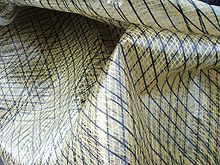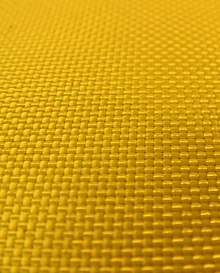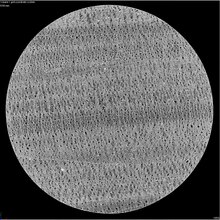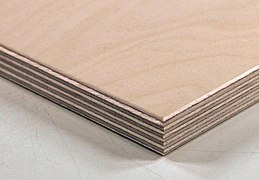Laminate
A laminate ( , from Latin lamina , layer) is a material or a product that consists of two or more layers glued together. These layers can consist of the same or different materials. The production of a laminate is called lamination.
purpose
There are generally two reasons for manufacturing a laminate:
- Combination of different materials so that the finished laminate combines the properties of all components, for example
- Floor coverings in which an inexpensive, stabilizing, but not very abrasion-resistant underlay with a decorative and robust top layer (e.g. imitation wood) is bonded to the laminate floor ;
- ID cards in which a printed card is glued between two protective plastic films as an information carrier.
- Controlled build-up of material according to the strength or quality requirements, for example
- in the manufacture of components made of fiber-reinforced plastics , whose fabric insert is concentrated in heavily stressed areas and whose fiber direction is based on the course of the tensile stresses;
- in the manufacture of plywood , in which the imperfections and the grain of the individual veneer layers are compensated for by gluing them to the other layers.
Laminate as a floor covering
Laminate floors imitate the appearance of a high-quality floor covering (mostly parquet ), but consist of an inexpensive carrier layer that is decorated and sealedwith a thin decorative layer . Such a floor is very cheap and easy to lay (compared to parquet or tiles, for example).
Laminate floors are available in different panel thicknesses and with different abrasion resistance (usage class) . Inexpensive laminates are relatively thin, have a relatively simple decor and are more sensitive to abrasion and moisture (especially in the abutting edges between two panels). High-quality laminates, on the other hand, imitate the look of a real parquet floor very realistically with structure embossing (to simulate a grained wood surface) and V-joints between the panels. Elaborate surface seals enable laminate to be used even on floors subject to heavy loads, such as in discos.
However, all laminate floors have one disadvantage in common: if the surface is damaged or worn, it cannot be sanded down like solid wood parquet, as the substrate would be exposed immediately under the decorative layer.
Laminates made from fiber-reinforced plastics
Laminates made of fiber-reinforced plastics are solid, light and freely configurable materials made of fibers embedded in synthetic resin. They are used in aviation, boat and automobile construction and in many other areas in which high-strength and lightweight materials are required.
Laminates are differentiated according to several criteria:
After their construction
- Full laminate, i.e. solid design: The component consists entirely of fiber-reinforced plastic. Such laminates are relatively heavy, but less sensitive to point loading, and easier to manufacture in tight radii.
- Sandwich laminate : A light but shear-resistant intermediate layer is inserted between two laminate layers made of fiber-reinforced plastic, which can be made of wood, aluminum, rigid foam or Nomex honeycomb, for example. This intermediate layer is decisive for the shape, strength and rigidity of the entire component, but leads to a weight and material saving compared to an equally rigid intermediate layer made of full laminate. A disadvantage is the sensitivity to puncture and point loading (if the cover layers are made too thin).
According to the material of the fibers used
- Pertinax (hard paper): paper in melamine, the electrically insulating material is brownish-yellow to dark brown and was historically the first material for printed circuit boards .
- Glass fiber laminate (GRP): inexpensive, readily available, in thin layers transparent to translucent. The colorless white fibers are resistant to UV light. Electrically insulating, waterproof - for modern, including multilayer circuit boards.
- Carbon fiber laminate (CFRP): very light and strong, but expensive. Electrically conductive and sensitive to impact. When using the appropriate fabric, the result is a visually attractive surface (so-called visible carbon ).
- Kevlar laminate : relatively insensitive to impact and point loads. Vibration dampening and electrically isolating. The fibers are UV-sensitive and can absorb moisture.
After aligning the fibers used
- Unidirectional laminate: the individual fiber layers only run in one direction. As a result, the fibers are very stretched and can absorb tensile forces particularly well. The individual layers are usually aligned in different directions in order to be able to absorb loads in several directions. The strength in each direction can be defined very precisely.
- Fabric laminate: consists of a fabric made of fibers. The fibers are interwoven and thus have warp and weft threads. While the weft threads are straight, the warp threads are woven through them. The warp threads can stretch under load, so the laminate is less stiff in the warp direction.
- Fiber mat laminate: the fibers lie on top of one another in a disordered manner. Since the fibers are not directed and not stretched, such a laminate is less stiff than the above.
- Spray laminate: This material is actually not a laminate because no defined layers are applied. Instead, resin is poured into a mold with a spray gun, with short (a maximum of a few centimeters long) pieces of fiber being added. The short and disordered fibers and the very high resin content ensure poor strength values and a high tendency to micro-cracks, which further weaken the material. In addition, it is impossible to precisely control the applied layer thickness. The only advantage is the very cheap production.
According to the material of the resin used
As a matrix for taking up and fixing the fibers, usually:
- Polyester resin : inexpensive and easy to process. Hardens quickly, but is relatively brittle and tends to form microcracks. Surfaces made of polyester resin are very smooth and shiny, so they are well suited for decorative surfaces or mold making.
- Vinyl ester resin : higher quality, but also more expensive than polyester. Less brittle.
- Epoxy resin : expensive and relatively complex to process. Long curing times enable long processing, but also require a lot of time. In order to achieve high strengths, a precisely defined post-curing at elevated temperature (so-called tempering ) is often necessary. Very elastic and high strength, excellent adhesive properties.
- Phenolic resin : very heat-resistant, therefore suitable for high-temperature applications such as brake linings or heat shields.
HPL (High Pressure Laminate)
Early on after the development of the first synthetic resins, it was discovered that they are suitable for impregnating inexpensive carrier materials such as paper, cardboard or textile fibers and processing them into hard paper , hard tissue or decorative HPL panels. For this purpose, several papers soaked with melamine and phenol resin are pressed together under pressure and temperature and with a top layer.
HPL panels (short for High Pressure Laminate) are also known in German as high- pressure laminate panels or DIN Decorative Plastic Laminate (DKS) and are offered under brand names such as Dekodur , Duropal , Resopal , FunderMax , Trespa or Sprelacart .
Thanks to the use of heat-resistant resins, the finished plates can withstand high temperatures (e.g. from embers of cigarettes and hot pot bottoms) for a short time without being damaged. The surfaces are easy to maintain and clean, light-resistant, odorless and insensitive to alcohol, organic solvents and water. Melamine resin surfaces are food safe.
HPL is used in many everyday products because of its scratch resistance and the variety that can be created by different printed papers. Table tops, door leaves, furniture, and kitchen tops are just a few of the common uses. If high impact resistance is not important or if the coating should follow the contours of the material, carrier plates can be provided with a direct coating. Then, for example, two papers impregnated with melamine resin or a so-called finish film are pressed directly onto the carrier material.
A variant of HPL marketed as environmentally friendly are the laminate panels known on the market as ECO-HPL. These are mainly pressed from recycled paper and produced without the use of artificial phenol - formaldehyde resins.
HPL panels are available in a wide variety of decors, surface structures and material thicknesses. In addition to many colors, replicas of metal, wood and stone surfaces are also offered. The electron beam cured laminate process is used to produce various surface structures. The design and application options are varied. Typical areas of application include:
- In kitchen construction and furniture construction, for fronts, table tops, kitchen mirrors, suspended kitchen lighting and pieces of furniture such as chairs, tables, cupboards and even for doors and door frames.
- In the sanitary area for toilet room dividers as well as for changing rooms and lockers in swimming pools
- In the construction sector as panel cladding for rear-ventilated and insulated building facades , roof overhangs and balcony parapets
- For interior fittings as wall and ceiling cladding, for partition walls and built-in furniture
- In shop and trade fair construction for sales equipment, room dividers or partition walls, cash desks, counters and other furniture, as well as for billboards
- In industry for workplace equipment (e.g. for tool cabinets and worktops) and for cladding machine tools
The material thicknesses range from 0.3 mm for direct coatings to 45 mm for so-called compact panels. When using pure phenolic resin, the material core is reddish brown, but can also be black, white or a different color due to pigmentation and colored paper inlays.
CPL (Continuous Pressure Laminate)
CPL panels (Continuous Pressure Laminate) are pressed into a type of endless panel in a continuous or endless process in roller belt presses heated on both sides. The pressure is lower than with HPL panels.
In German-speaking countries these laminates are also called decorative laminate (abbreviated DKS = decorative plastic laminate) or simply decorative laminate .
Other types
By using special materials, increased resistance to the effects of flames can be achieved. A heat dissipating layer, e.g. B. a metal foil, makes the plate resistant to cigarette burns by quickly dissipating the heat.
Various board properties, such as tensile / flexural strength, abrasion resistance, scratch and stain resistance, behavior towards cigarette burns, hot saucepan bottoms, boiling water, etc., are regulated in test standards.
Papers and resins used for postforming plates allow the impregnation to subsequently soften, since the crosslinking of the plastic molecules is not yet complete. Deformation under the action of heat and pressure is possible in order to glue the laminate board, for example, around the rounded edges of the carrier material.
Wood-based materials
Many well-known wood-based materials are also laminates, for example
- Plywood with its subspecies, such as multiplex panels , blockboard , as well as form- glued plywood , in which the individual veneer layers of the plywood are not glued on a flat surface, but in the intended shape, whereby relatively complex shapes can be produced.
- Kaltverleimtes of laminated wood is similar to formverleimtes plywood from many, bonded at room temperature veneer layers. Here, however, the grain runs parallel in all layers, so that the molded part has similar properties to solid wood. In contrast to plywood, locking (twisting of the layers relative to one another) is usually not done for optical reasons.
- Worktops and furniture fronts in which a chipboard or MDF board is glued with veneer or a protective plastic decorative layer (HPL, melamine or RTF / Rigid Thermal Foil).
- Strictly speaking, OSB panels (oriented strand board, coarse chipboard ) are not to be referred to as laminates, as they are not made up of defined layers (Latin: laminae).
- Various laminated wood materials
Laminated steels
Damascus steel is made by forging two different types of steel together and then repeatedly drawing, folding and hammering. Such a piece of steel can have up to dozen of layers of steel. By hammering or rolling in a dent pattern, the layers are arched and, when sanded flat, result in the characteristic rhythmic pattern, whichbecomes more visible and tangiblethrough oxidation or etching . By combining a hard and a tough type of steel, blades for knives and edged weapons are achieved that combine both properties. Small notches appear at the material transitions on the cutting edge, which act like fine saw teeth. One also speaks of laminated steel.
Sealing of printed matter
In this context, lamination refers to the welding of documents, photos or similar printed matter between two transparent plastic films (polyester films). As a result, normal paper is protected from moisture, kinks and damage, manipulation is also made more difficult and labels can be easily removed again if necessary. The laminating foils are mostly sold as so-called laminating bags or in the service sector as rolls that are processed on large laminating machines. The lamination pockets are folded in the middle, which makes it easier to straighten documents. There are different thicknesses of laminating foils. The information is usually given in micrometers (often referred to as µ , Mic, Mi or Mü ) and relates to a layer thickness of the film. For example, if 80 microns are specified, the thickness of a laminated document is 160 micrometers plus the thickness of the paper. There are two types of processing:
- Hot lamination: Here, the paper is inserted into the film and guided over a hot roller in a laminating device , which fuses the two plastic layers together at around 60 to 120 ° C using heat and pressure.
- Cold lamination: Here there is an adhesive in the foil pocket that is already bonded to one another by pressure. Cold lamination can therefore also be carried out by hand without a special device.
Other uses of the term "laminate"

- One-sided protective lamination of printing works with adhesive films, mostly outdoors for information boards and the like to protect against weather, UV light or vandalism such as graffiti .
- Laminate sails made of high-strength fibers that are fixed and protected by double-sided foils or fabric layers.
- Textile laminates in which a breathable membrane layer that is permeable to water vapor is bonded to cover layers in order to protect the membrane from damage.
Web links
- About lamination in the finishing dictionary
Footnotes
- ↑ See also www.design-4-sustainability.com
- ↑ See also www.bm-online.de ( Memento from September 27, 2013 in the Internet Archive )
- ↑ a b See also www.icdli.de
- ↑ Further information at www.Holzhandel.de












